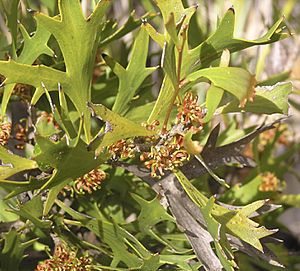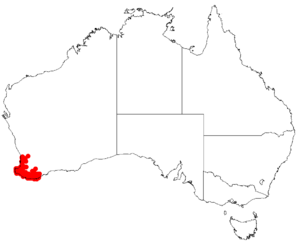Horned leaf hakea facts for kids
Quick facts for kids Horned leaf hakea |
|
|---|---|
 |
|
| Hakea ceratophylla growing near Mount Barker | |
| Scientific classification | |
| Genus: |
Hakea
|
| Species: |
ceratophylla
|
 |
|
| Occurrence data from AVH | |
The Horned leaf hakea (scientific name: Hakea ceratophylla) is a special type of shrub found only in the southwest part of Western Australia. It's part of the Proteaceae plant family. This plant is known for its stiff branches and leaves that can have different shapes, sometimes even looking like horns! Its flowers are usually white or have a rusty color.
Meet the Horned Leaf Hakea
The Horned leaf hakea is a stiff shrub with many stems. It usually grows to be about 0.5 to 2 metres (1.6 to 6.6 ft) tall. When the plant is young, its branches and leaves are covered in rust-colored hairs. But as it gets older, these parts become smooth, meaning they lose their hairs.
The leaves of a grown Horned leaf hakea can look very different from one another. They can be long and thin, or shaped like a narrow egg. These leaves are usually 4.5 to 23 centimetres (1.8 to 9.1 in) long and 0.2 to 1.4 cm (0.08 to 0.55 in) wide. Some leaves even have three to five "lobes," which are like small horn-shaped parts. These lobed leaves can be 3.5 to 8.5 cm (1.38 to 3.35 in) wide, with the lobes themselves being 1 to 26 mm (0.04 to 1.02 in) long.
The flowers of this hakea grow in small clusters, usually with two to ten flowers in each. Each flower sits on a tiny stem, about 2 to 5 millimetres (0.079 to 0.197 in) long, and is covered in white and rust-colored hairs. The main part of the flower (called the perianth) is 4.5 to 6 millimetres (0.177 to 0.236 in) long.
Horned leaf hakea plants bloom from September to December. After the flowers, black, egg-shaped fruits appear. These fruits are about 2 to 3.5 cm (0.79 to 1.38 in) long and 0.9 to 1.3 cm (0.35 to 0.51 in) wide. Inside, there are two seeds, each about 1.2 to 2 cm (0.47 to 0.79 in) long, with a thin wing on one side.
How Did It Get Its Name?
The Horned leaf hakea was first officially described in 1807 by a scientist named James Edward Smith. He originally called it Conchium ceratophyllum. He published his description in a large book called Rees's Cyclopædia. The very first plant specimen used for this description was collected by Archibald Menzies at King Georges Sound. Smith thought it was "one of the handsomest of its genus."
Later, in 1810, another botanist named Robert Brown changed its name to Hakea ceratophylla. The second part of its scientific name, ceratophylla, comes from two ancient Greek words: keras (or keratos), meaning "horn," and phyllon, meaning "leaf." This name likely refers to how some of its leaves have horn-like shapes.
Where Does It Grow?
This shrub is found only in the southern parts of Western Australia. You can find it in regions like Peel, South West, and Great Southern.
It likes to grow in places that are sometimes wet, like damp flat areas, or among granite rocks. It can be found in sandy, loamy, or gravelly soils. The Horned leaf hakea's range stretches from near Perth in the north, south to around Albany, and inland towards the Stirling Range area. It often grows in open shrubland or in woodlands where Melaleuca trees are common.

